Steering technique
In this article I will not try to persuade you to use one steering technique because is better than other. This has been an ongoing debate from time of invention of the steering wheel. I've encountered a lot of techniques and "styles" of gripping and turning the steering wheel, whether on the road or in advanced driving schools. But if you talking with any of experienced drivers or racing drivers, they will found most of the methods to be insufficient in applying accurate steering input. Push-pull, Fixed Arm steering, shuffle steering, palming and rotational (Hand-over-Hand) steering methods are all acceptable when employed properly to aid responsible car control. Less experienced drivers will always try to defend style they use.
The art lies in being able to choose the right technique in the right moment. By saying that I mean that you have to know the vehicle type, road conditions and by ensuring the method allows a safety margin for the unforeseen although hopefully anticipated.
Rather than focus on the negatives, remember the positive benefits of each style and experiment by employing them all and assessing the results.
You have to be adaptable, flexible and to adopt a proper approach to car handling skills. There is no one way to steer. You have to switch between rotational, palming, push-pull and fixed arm as it needed. I discussed it with some racing drivers and they agreed that different technique is required at different times. Good steering technique is crucial for smooth driving, as it prevents any sudden lateral weight transfers which allow the corner to be taken at a higher speed.
I've watched in-car footage of an invitational race a Long Beach GP some years ago where the driver ran the entire race with one hand on the wheel and one on the stick. He won. There are always going to be exceptions to the rule. Unfortunately, lazy bums that we are sometimes, those exceptions can turn into terrible habits that can become costly accidents.
Finally, the evolution of the car has had much to do with our method of steering. I certainly don't want to tell Lewis Hamilton or Felipe Massa that they must abandon their fixed hand steering method in favor of the shuffle method. Nor do I want to tell a NASCAR champion that he must use a fixed hand steering method! Again, you have to be adaptable, flexible and to adopt a proper approach to your car and situation you are in.
Here si the video of Juan Manuel Fangio on board camera, and you can see how he preparing position of his hands for next turn. This driving style is known as "Fangio shuffle"
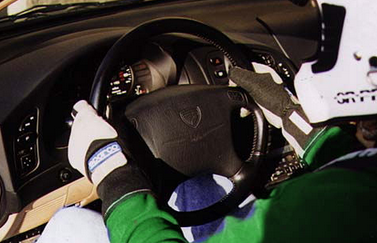 |
In Fangio Shuffle your hands are mainly on 15 to 3 position ready for any emergency situation. You can keep hand in this position during non demanding corners |
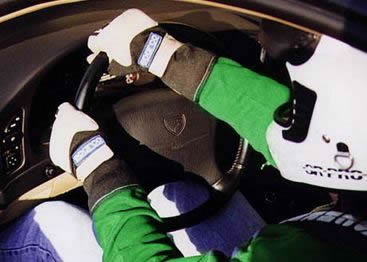 |
Before corner you can shuffle one hand to prepare entering. Normally you don't need to shuffle hands any more during corner, you have always one hand on the steering wheel ready for emergency. On the picture you can see preparing movement for right corner. |
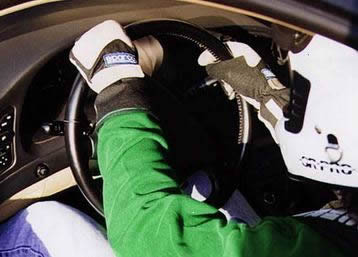 |
As you can see, right corner is now very easy. You have enough space for further movement if it's necessary, and enough freedom to go back in case of emergency. |
I do know one thing: I'm naturally using the 'Fangio Shuffle'. In this method you shuffle your hands in better position before you start cornering. This is a blended hybrid style that incorporates bend assessment and pre selective hand positioning with leverage and security mid bend in mind. In this way you can anticipate the turn and shuffle the hands into a 'ahead of the curve' better position, and that is only logical (for me). But then I'm actually paying strict attention to my driving when I'm behind the wheel. 90% of the population only thinks they are, and that's the real danger! I'm using this method when I'm on the racing track or when I'm driving on the faster, demanding road.
Here si another video of Stirling Moss on board camera at Brands Hatch 1964 and you can see that he is using similar technique and how he preparing position of his hands for next turn.
When I'm with my family (slow driving within the road limits), and I'm tired or on long trip with flat straight road, I'm using 10 minutes to 2 position. The reason why I like to use 10 to 2 position in the first place is because it's more comfortable, since in that position, the weight of the hands lay partially on the steering wheel. But this comfort becomes agony when bigger steering input is required. Amount of steering one can make from 10 to 2 fixed position (without shuffling or crossing hands) is limited, since both hands "collapse" into the turn, and one hand can't cover for the other. This also utilizes the muscles in the shoulders, requiring more effort and sending the body out of balance, as if it was "dangling" over the steering wheel.
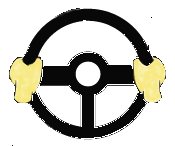
If I'm driving on more demanding road, then I like to hold steering wheel 15 to 3, and there I have a clear sense of balance and control. Moreover, the steering wheel is usually meant to be held this way: The links between the steering hub and wheel are intentionally located in 15 to 3 on most cars, so that the thumbs are wrapped around them on this position, providing more stability, and easy access to light switches and blinkers. Some steering wheels have little "bumps" on the inside of the rim.
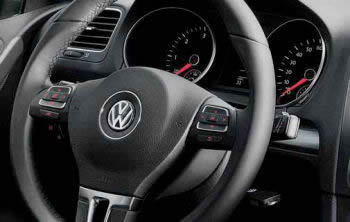 |
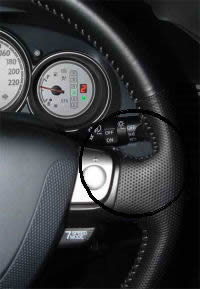 |
| These are meant to create a "gap" to place the thumbs in it, while the steering wheel is correctly held in 15 to 3. |
There's also another point: The airbag. This is a bomb set inside the steering hub. No, I mean it, it's a small bomb that makes an airbag deploy at 300 kmh! If you holding steering wheel in 10 to 2, the airbag might crush the arms and also send them flying at your face. This risk is reduced when holding the rim and 15 to 3.
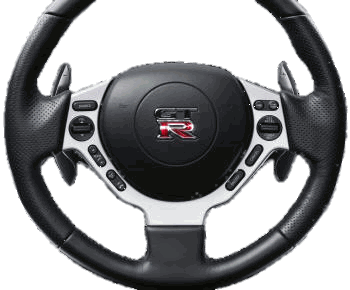 |
You can see this bumps or thumbs holders on the inside of the Nissan GT-R steering wheel. All high performance car have it, so it' mean there is sense in it. |
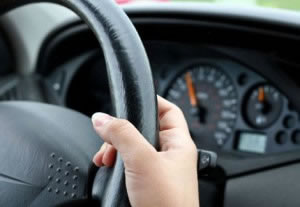 |
Woman hand in correct position holding the wheel in more relaxed womanly way |
In this position, we can also make a lot of steering without shuffling our hands.
In some driving schools the first rule is that when driving in the open road, or in small and progressive bends, the hand should remain in the fixed 15 to 3 positions, and steering adjustments should be made from this position. It's enough even for emergency evasive maneuvers. Actually, if I want to make an emergency lane change, all I have to do is steer all the way from the fixed position to the right, then all the way left, and back straight. If done quickly enough (just over a second) and without excessive throttle or brakes, this results in moving the car exactly one lane over to the right!
But when I'm driving in the more demanding open road, on the track or in small and progressive bends, I like to use the 'Fangio Shuffle'. That mean, hand position generally on 15 to 3 position with shuffling hands in better position before you start cornering (if it's necessary to shuffle, depend of the corner).
Bay the way, if you brows trough internet, you will find so many driving schools and instructors, and each of them supporting different way how to hold and use the steering wheel. That is war without winner. Important for us, normal drivers, is to use common sense. If you feel that push-pull method is not for you, don't use it. If you don't feel safe enough to use shuffle method, don't use it. Shuffle steering is not so smooth. It still requires many continuous hand movements. Use method that suits you, important is that is used in right way. You can't use push-pull method for fast cornering and advanced driving. It's simply to slow, and you can't be precise trough corner because your grip on wheel is not constant, and you can't get all feedback from the wheel changing hand position all the time. As you can see at this video of in car camera footage of Marty McCormack & Phil Clarke in their Rally Citroen C2 R2, Marty is not shifting his hands, and position is in 95% of the time at 15 to 3.
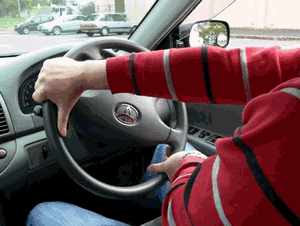 |
This move must be painful for his left hand. In this case, left hand should be shuffled in better position, as in lover picture. It will give you better comfort and more control. During position change of left hand (in this case), do not move your hand of the wheel. Try to keep your palm on the wheel for better control in case of emergency. |
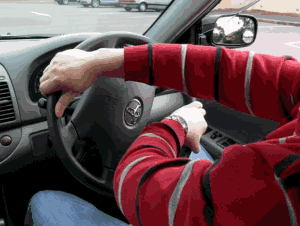 |
The grip itself should be relaxed - just tight enough to maintain control and good contact for sensory input. A tight grip on the wheel will tire your hands and arms quickly, and more importantly will significantly reduce the sensitivity to the vibrations needed to sense and control limits of the car. While it is a natural tendency to grip the wheel tightly while corning, no amount of squeezing on that wheel will increase the traction of your tires! However, the more relaxed the grip (without losing contact with the wheel), the more of that traction you will be aware of. It is a learned response to relax your hands (in fact, your entire body) during high g-force cornering, but it is something that you must force yourself to learn as quickly as possible. It will increase your sensitivity to the car's traction limits, and improve your awareness of the car's handling. So, grip the wheel with a firm but relaxed grip, but not so hard that your knuckles turn white! Try to maintain this position unless it isn't possible to take the corner in this way, as this gives you the advantage of instantly knowing exactly where the straight ahead position is, and the ability to steer rapidly yet smoothly.
A lack of understanding of the mechanics of driving and too little precision and understanding in operating the vehicle controls will always end in grief when the pressure is on. It should be remembered that many functions involved in driving a car are closely linked. If you misjudge a bend, and go into it a little too fast, you can usually get away with it providing you have good discipline and knowledge about controls and your car behavior. If you have poor steering knowledge you won't make it. Same will happened if you just stamp in the brakes. The steering wheel is the most important item on the list of vehicle controls because it has such a profound effect on the behavior of that vehicle and there are a number of side effects it creates also. It can drastically change the balance of the car in terms of where the weight is shifted. In fact it can cause a whole storm of forces that can be all mixed up and thrown in just about every direction, but do many drivers understand that?
When steering round a corner, ideal steering movement is progressive, smooth and controlled. Applying and taking off steering lock should be done in a fluid movement, without taking either hand off the wheel where possible. 'Push and pull' the wheel may be fine for general road driving, but this does not allow the smooth motions needed when driving near the limits of grip or in emergency situation.
Try not to let the steering wheel slide through your fingers when letting off steering lock, and then adjust your hand position accordingly for the next corner or straight.
In some situations when you need to take the lock off very quickly - you may find it easier to let the wheel slide through your fingers slightly, but this should be avoided where possible. An example could be when letting off the steering lock after a dramatic oversteer correction. When taking a corner, aim for the apex and turn in a smooth controlled arc - don't use aggressive steering unless you're deliberately trying to unsettle the car (e.g. for a handbrake turn). Once you've clipped the apex, unwind the steering lock progressively as you increase the throttle. And please, don't brake trough the fast corner, never.
When a car is travelling straight ahead and you turn the steering wheel either left or right, the momentum (centrifugal force) within the car still wants to take it straight ahead. The front wheels have now got to fight that straight-ahead force by creating a counter-force of their own through the front tires, if they are going to cause the car to deviate left or right, and that counter-force to be stronger than the straight-ahead force if it is going to win. If you load up the steering gently and gradually the car will corner far more effectively than if you try and jerk it around. Check my article about traction circle to make this clear.
The steering wheel is where you will get most of your feedback of the road or track surface from the front tires, suspension, and brakes. As simple as steering may seem to be, for maximum control and smoothness, there are definitely some things you should be aware of.
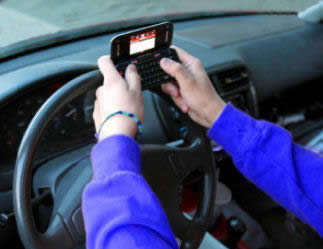 Your hands will spend a great deal of time on the steering wheel, so for both sensory input and comfort, how the steering wheel feels in your hand is important. Depending on the size of your hand, you may want a wheel that is thicker or thinner. The exact style, size, and construction are up to you. If you're thinking of changing from the stock steering wheel, choose one that is comfortable gripping the wheel with or without your driving gloves on.
Your hands will spend a great deal of time on the steering wheel, so for both sensory input and comfort, how the steering wheel feels in your hand is important. Depending on the size of your hand, you may want a wheel that is thicker or thinner. The exact style, size, and construction are up to you. If you're thinking of changing from the stock steering wheel, choose one that is comfortable gripping the wheel with or without your driving gloves on.
When getting ready for the road you should adjust your seat to a much more upright position than you may use. And don't text during driving!!
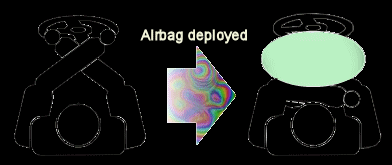
One last word about steering, and this concerns the steering wheel itself. All modern cars these days have a drivers' airbag fitted and that airbag is contained within the steering wheel centre and that airbag has a detonator and an explosive charge within its system, also contained within the steering wheel hub.
The whole thing is like an unexploded bomb and if it goes off, and that airbag deploys when your arms are across the steering wheel centre, it will break your bones as if they are toothpicks and trow your hands in your nose breaking it in the process!
I recieved an funny email from Tracy. There is a mail:
"In your explaination of steering techniques there is one technique that you forgot to mention and that is; steering with your knee! This is a technique that we used to do in High School when we were rolling joints and cigarrettes while driving. We just used to put our knee up under the steering wheel and move it left or right, however much we needed to keep the car on the road. This way we could drive at a fairly good speed and roll a joint at the same time. With a lot of practice we became quite good at doing this! Of course this was many years ago when I was a young man and used to smoke dope, but I still do this today if I'm driving and have to take off my jacket or something like that!"
Here you can learn more about steering wheel and steering column.
To have a complete picture of performance driving, take a look at Corners, Setup, Traction circle, Using tires, Left foot braking, braking, advanced braking, WRC braking technique, Slipstreaming, drifting, cornering, shifting, Heel and toe driving technique articles






